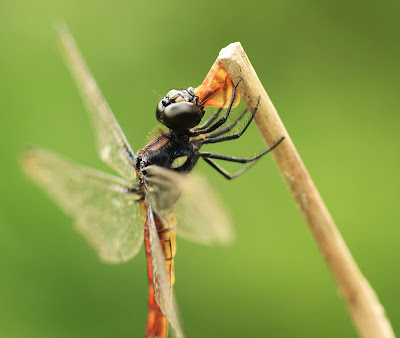Lyriothemis bivittata is a robust and medium-sized libellulid, characterized by a dark brown synthorax with 2 broad markings at the sides and a reddish abdomen. Wings hyaline, only very slightly darkened in the basal one or two cells.
The male has a red abdomen and a striking white face (labrum, anteclypeus/postclypeus, frons). Top of antefrons shining blue-green.
Male, from Cuc Phuong NP.
Male, head, from Tam Dao NP.
Same male, from Tam Dao.
Wing venation, male.
The female (photos from the foothills of Tam Dao National Park, along a slow flowing streem in disturbed forest) has a broad orange yellow abdomen, changing reddish brown in old individuals. Face blackish. Wings smoked pale brown in aged insects.
Before this little fellow grabbed its lunch (a tiny butterfly), it was difficult to get near.
Lyriothemis bivittata is known from India, Nepal, Myanmar, Thailand, Vietnam and Laos, but seems to be scarce everywhere. Indeed, this species is not often recorded, Hämäläinen and Pinratana (1999) describe it as a “rare forest species”. It breeds (at least sometimes) in water filled tree holes and is likely to be under-recorded.
































